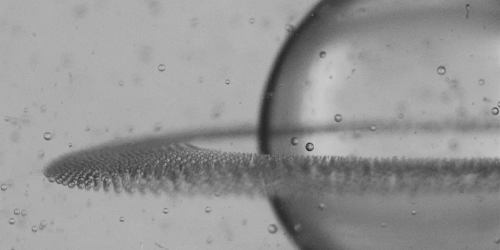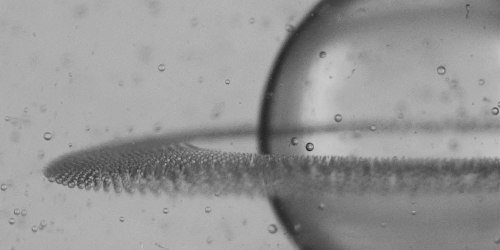Saturn-Shaped Drops
Place a drop of liquid in an electric field and it will stretch out along the field direction, forming jets that spray tiny liquid beads out of each end. Now Quentin Brosseau and Petia Vlahovska from Brown University, Rhode Island, have uncovered a new behavior where, instead of jets, the drop extrudes rings of liquid from its equator, resembling the planet Saturn.
Jet spraying occurs when the drop is filled with liquid that is more conducting than the fluid in which it is suspended. When an electric field is applied, the liquid at the surface of the drop flows from the equator to the poles. As a result, the drop stretches along the polar axis, so that it resembles an American football with two pointy cones at each end. The pointy interfaces are unstable and tiny beads of liquid spray out. This behavior occurs in thunderclouds and ink-jet printers, in which droplets are surrounded by poorly conducting air.
In their experiments, Brosseau (now at New York University) and Vlahovska (now at Northwestern University) flipped the system around—using a silicon oil drop that was less conducting than the surrounding fluid of castor oil. This time, the liquid at the surface flowed to the drop’s equator rather than its poles, causing the millimeter-sized drop to flatten into the shape of a lens. Again the drop’s interface was unstable, and it shed thin rings of liquid that subsequently broke up into beads about 10 micrometers in size. This shedding continued for a few tens of seconds until the original drop was transformed into thousands of uniformly sized beads. Although not fully understood, the process could be used to precisely dose out pharmaceuticals in tiny liquid particles or to create thousands of microreactors for high-throughput chemistry experiments.
This research is published in Physical Review Letters.
–Katherine Wright
Katherine Wright is a Contributing Editor for Physics.





